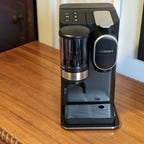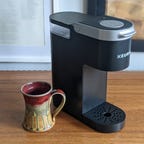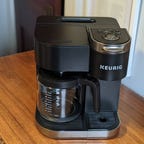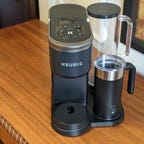Best Keurig Coffee Makers for 2024
The convenience of a Keurig machine is exceptional. If you often find yourself making a single serving of coffee, consider one of these machines for your home.
Our Picks

What is the best overall Keurig-style coffee maker?
A Keurig coffee maker will make your morning cup quick and easy by offering the convenience of a tasty single-serve coffee. These pod-based machines are likely to be more affordable than classic drip coffee makers. The best Keurig coffee makers are also the best way to brew coffee that's easier or more convenient. The Keurig K-Mini stood out for just that reason.
And if you're worried about being environmentally conscious, if you switch the single-use K-cups for a compatible reusable one, you'll avoid the plastic waste that's been the biggest mark against this style of coffee maker.
If you love a Keurig coffee maker for its convenience, capacity (check out other small portion options like French presses or pour-over cones), or you just love the overwhelming variety of available K-cup flavors, there's an option for you on this best list. This roundup focuses on Keurig brand machines but also includes compatible coffee makers from other brands. You'll find everything from simple machines with one function to app-connected options that adjust to any pod and allow you to create custom recipes. (You can also check out how to clean your Keurig coffee maker.)
Best Keurig-style coffee makers of 2024
The K-Mini is about as simple as it gets. Fill your mug with water, empty it into the reservoir, add your coffee pod and punch the brew button. In less than 2 minutes, your cup of coffee is ready. The coffee I got from the K-Mini, like all of the options here, didn't reach our extraction standards for brewed coffee, but it consistently brewed stronger than any other machine I tested. With a brew time of 1 minute, 45 seconds, it's a little slower than some of the Keurig machines I tested, but it's still faster than some other brands.
The best thing about the K-Mini is how simple and easy it is to use. While you have to add water to the reservoir each time you want to make coffee, it's easily accessible, even when I had it under my kitchen cabinets. It's simple to clean and doesn't take up a lot of space. It's an unfussy, capable machine at under $100.
Best for big batches
Keurig K-Duo
The Keurig K-Duo allows you to brew a single cup of coffee or a whole carafe. While it's not the only machine that offers both options, its single serve brewer does the job a bit better than the others. In our tests, it extracted a little more coffee from the dry grounds than its competitors. It served up coffee that was hotter than the other dual coffee makers we tested, too. (For this test we measured temperature in the cup, a much less precise test than in the brew basket as we do for drip coffee machines. In this case however, it's safe to say there's a difference of several degrees between the K-Duo and the other dual brewers we tested.)
The K-Duo can brew a six, eight, ten or twelve ounce cup of coffee or a six-, eight-, 10- or 12-cup pot of coffee, which is also a larger range than some of the others. It comes in at a lower price, too.
Best for fresh coffee
Cuisinart Grind and Brew Single Serve Coffee Maker
If you're looking to improve your coffee game, the easiest way to do so is grinding fresh coffee beans right before you brew them. The Cuisinart Grind & Brew, which has a built-in coffee grinder, makes it easy to incorporate freshly ground beans into your coffee routine -- even with a single-serve machine. Simply measure out your preferred amount coffee, place your reusable pod in the rest beneath it and grind your coffee. Pop on the cap and brew it up. You can't make it much fresher than that. And for incorporating a grinder, this Cuisinart doesn't take up much counter space. It has a removable water reservoir and brews eight-, 10- and 12-ounce cups.
While our testing shows it doesn't brew a cup as well-extracted as the Keurig K-Mini, it still landed in the top third of those we tested. The Cuisinart DGB-2 has more moving parts, but the parts that require cleaning are easily accessible.
Best for customizing your coffee
Keurig K-Cafe Smart
If you want the convenience of K-cup coffee, but also want to customize brew recipes and create unique drinks from what you make, the K-Cafe Smart gets you. The K-Cafe Smart has a single-serve brewer, a detachable water reservoir and a milk frother. It also reads the QR code that comes printed on most K-cups and adjust its brew settings to fit that specific coffee. (I had a hard time figuring out how to test or verify this feature. It accurately identified every K-cup variety I tried.)
The K-Cafe Smart has the unique ability to brew "shots" of coffee: smaller, punchier portions of coffee aiming to approximate a shot of espresso. To my taste this wasn't close to a shot of espresso, but it did brew coffee that could be used to make tastier drinks. (Adding 6 ounces of hot water was my favorite form.)
In the mobile app, through which you can connect your phone to the K-Cafe Smart, you can find and customize recipes and control the coffee maker. (Your phone will need to be running iOS 13 and higher or Android 8 and higher.)
Best for small spaces
Keurig K-Mini
The K-Mini from Keurig already takes the top spot on this list, so it's an easy to slot it in here too. While it's not the smallest model I tested, it's still a slender machine and performed a bit better than the smaller options. Just 4.5 inches by 11.5 inches by 12 inches, it'll fit into plenty of cramped places. To open the lid to the water reservoir (which you'll do each time you make a cup of coffee) you need 16 inches of clearance. It should fit on the counter under most cabinets.
The Proctor Silex and Frigidaire single-serve models are of a comparable small size, but require more clearance to fill the reservoir and weren't as easy to use under cabinets. The K-Mini also extracted more coffee from grounds that these other small options.
Other K-cup compatible machines we tested
Frigidaire 1-Cup Single Serve Retro Coffee Maker: This machine from Frigidaire was a speedy and did the job. It has no frills and is the cheapest option on the list at just $38. It does feel and look a bit cheaper than the others on this list, but will brew a cup of coffee in under 2 minutes.
Proctor Silex Single Serve Coffee Maker: Proctor Silex's entry on this list is in the same tier as the above Frigidaire. It's a bit slower than that one, but provides a similar bargain price.
Hamilton Beach FlexBrew Single-Serve Coffee Maker: The Hamilton Beach single-serve option is still quite affordable, just $75, but adds an additional feature: regular and robust settings. In our testing, the robust setting did have a modest but real increase in the strength of the coffee.
Hamilton Beach FlexBrew Dual Coffee Maker: This coffee maker is essentially the above Hamilton Beach attached to a drip machine. The single serve portion did not perform noticeably differently from its standalone counterpart. It's a bit cheaper than the Keurig K-Duo listed above, but the K-Duo feels more solidly made and brewed coffee a bit better.
Cuisinart Coffee Center 2-in-1 coffee maker: The Cuisinart 2-in-1 Coffee Center brews both single servings and carafes with both bold and regular options. It has additional features -- like the option to keep a carafe of coffee warmed to different temperatures -- but none that made it comparable to the K-Duo in my estimation, which felt more solidly constructed and brewed better in our tests.
Keurig K-Supreme: The K-Supreme, like the other Keurig machines on the list, performed a bit better than other brands. It's a smaller option with a detachable reservoir. It has four size options and settings for strong coffee and brewing over ice. If you want a couple more options than the K-Mini, but don't want to inundate yourself, it's a good choice.
Ninja Dual Brew Pro: This Ninja coffee maker can do it all and was a close contender with the K-Cafe Smart for best for customizing. It can froth milk brew carafes and coffee pods and even has a separate dispenser for hot water, all with a smaller footprint than the K-Cafe Smart. To my taste and our tests it didn't brew quite as well as the K-Cafe Smart, but at $180, is relatively cheap comparatively.
How we tested Keurig-style coffee makers
Testing K-cup compatible coffee makers varies from testing other coffee makers, but still involves a mix of objective and subjective measures.
To test single-serve coffee makers, we measure how fast the machine brews, and the extraction percentage and temperature of the final cup of coffee. The speed test is a simple matter of using a stopwatch to measure the time from pushing the button to start the brew to the time the cycle is complete.
Measuring temperature is less reliable in single serve machines than in drip machines because it can't feasibly be measured at the point the grounds and water are actually meeting. For these Keurig-style machines, we measured the temperature in the mug of brewed coffee rather than the brew basket. Because the conditions are harder to control outside the coffee maker (mug temperature being the big variable), the temperature reading has less weight in the rankings here than in other coffee makers.
The most valuable data to ranking Keurig-style coffee makers is the extraction percentage -- the amount of coffee that is actually moves from the ground coffee to the final cup. We calculate this by starting with a Brix reading from a refractometer. (Brix is one measure of dissolved solids in a liquid. A refractometer calculates Brix, and other measures) by reading how much light bends when passing through a liquid.) For each machine, we brew three test cups and take 10 Brix measurements from each. We calculate the average Brix measurement for each cup and use that to calculate the extraction percentage.
Testing also relies on subjective criteria. We look at how easy the machines are to use and clean. We also sip each cup we brew to see which one makes the tastiest coffee. We explore specific use cases as best as we can. For example, our pick for small spaces was determined by the machines actual dimensions, but also, using each candidate in an actual small space.




